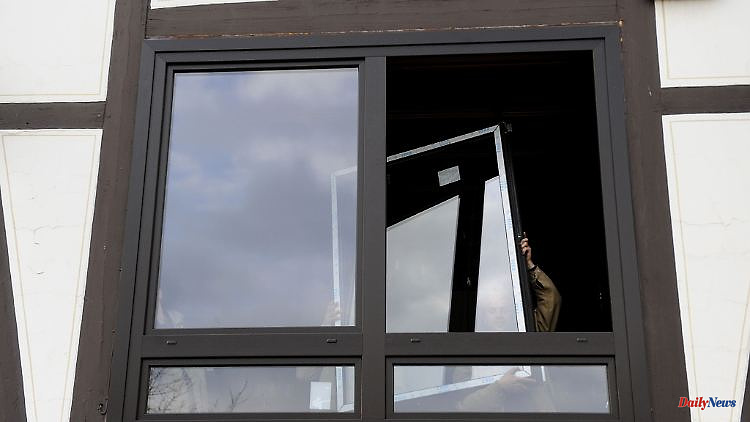The windows in many houses are often a few or even several decades old. Owners who replace them can save heating energy.
In older houses, the windows are one of the weak points in the building. If they are no longer properly sealed, they let a large part of the heating heat through to the outside. And even with older models, which are actually airtight, you often literally throw more heat out of the window than with modern windows.
According to the Institute for Window Technology (IFT) in Rosenheim, a modern, triple-glazed window can have an insulation effect that is around 80 percent higher than a window with single glass. And when replacing double glazing with such a modern triple window, you can achieve an improvement in insulation of around 70 percent.
How do I know the standard of my window at home?
How often the windows at home are glazed can be found out with a lighter: The flame is reflected in the glass as often as there are panes in the window, explains the Window Façade Association (VFF). If not only the yellow flame is reflected in the glass, but also reflections of a different color can be seen, this is thermal insulation glass. It consists not only of several panes, but also of heat-reflecting coatings and an inert gas filling between the panes. This means that the reflections of the individual panes are different in color, for example they can appear bluish.
Windows with double thermal insulation glass have usually been installed since around 1980 and insulate well, according to the association. The triple thermal insulation glass, which has been used since around 2003, has an even better insulating effect. As a rule, the younger the windows are, the better they can keep heat in the room.
Standard insulating glass was installed until around 1995. Such windows are now considered to be less energy-efficient or heat-insulating. A flame is reflected in it several times, but the reflections do not have different colors. Because it is a glass made of two joined panes, without a heat-reflecting coating in between.
Single-glazed windows were common until about 1978. Only a single flame is reflected here. However, these window panes can also be recognized by the cold glass surface as well as by the icing and condensation that can form on the pane depending on the weather.
At the same time, compound windows were installed until about 1980. These can be recognized by their two connected wing parts, which are opened together. Casement windows were used until around 1960 - these are two individual windows that have to be opened separately one after the other.
How do I find out if my window is still airtight?
For example, by slowly guiding a burning incense stick or a candle flame along the window frame. Where the smoke trail moves or the flame flickers, warm air can escape through the window.
How complex is a window replacement and how long does it take?
That depends on the building and the windows, according to the Window Façade Association (VFF). If the existing window frame is not removed, dirt and work intensity are manageable. But even if you have the window frame removed, it is usually possible to replace the window in each room within one day. The VFF recommends planning an exchange at least six months in advance. Because the craftsmen and companies are well utilized.
Can I replace the windows myself?
The installation of window elements is not a job for do-it-yourselfers or for caretaker services, says Thomas Gerke, master carpenter, wood technician and do-it-yourself lecturer at the DIY Academy in Cologne. Such components are technically complex and heavy, and many aspects have to be taken into account when measuring and assembling.
"Improper installation will result in major structural damage and can be life-threatening for users or passers-by," warns Gerke. "Even small assembly errors lead to the loss of the product warranty, cause malfunctions and make it impossible to achieve the energy saving potential."
How much does it cost to replace the windows?
The renovation costs have increased by an average of 20 percent since 2021 as a result of the crises and inflation, reports the VFF. According to a study by the association with the Federal Flat Glass Association from May 2021, the prices at that time were 500 to 750 euros per window unit with an area of 1.30 meters by 1.30 meters, depending on the frame material.
Are there any grants?
There are grants from the Federal Funding for Efficient Buildings (BEG). Among other things, there are 15 percent of the renovation costs for individual measures such as the pure window replacement. This is requested from the Federal Office of Economics and Export Control (BAFA) by an energy consultant before work begins.
Anyone planning a comprehensive renovation of the entire building shell and thus making the house an efficiency house 40 or 85 can receive a repayment subsidy of up to 20 percent from the KFW development bank. Further subsidies are possible if, for example, you carry out particularly sustainable renovations. The VFF subsidy assistant at www.fenster-können-mehr.de provides an overview of the currently applicable BAFO grants and KFW loans as well as options that only exist in the respective federal state.
Alternatively, 20 percent of the renovation costs can be offset directly against the tax liability spread over three years. A simple certificate from the executing window company is sufficient for this.
However, there is a requirement for all these funding opportunities. The new windows must comply with a specific parameter, the heat transfer coefficient. Craftsmen use the so-called Uw value as a parameter for the entire window. It may not exceed 0.95 watts per square meter and Kelvin (W/m²K). A value that modern, triple-glazed windows achieve.












